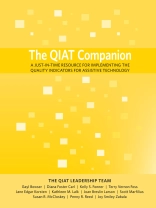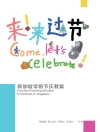Due to popular demand, the authors of the Quality Indicators for Assistive Technology: A Comprehensive Guide to Assistive Technology Services now offer this practical companion to the original book, which will help students, families, school professionals, and communities work together to meet the educational needs of every student.
The original Quality Indicators for Assistive Technology, or QIAT, were developed by a team of experienced leaders in the field of assistive technology (AT) in education over nearly two decades. Drawing on contributions and feedback from thousands of educators and families, the Indicators offer extensive support for the development and implementation of AT services, including research-based information, resources, and scenarios. They collectively support AT decision-making and actions at all points of AT service delivery and ensure that they
- align with specific areas of special education processes;
- describe the core components of quality AT services in eight areas; and
- require a team approach that emphasizes student and family voice.
The indicators, intent statements, and supporting materials for each area are used as guideposts for developing and sustaining effective, efficient, and ethical AT services across the country and internationally.
This new volume, The QIAT Companion, offers educators and families an action-based, ‘just-in-time’ resource written by the QIAT authors themselves.
表中的内容
Introduction
Chapter 1: Quality Indicators for Consideration of Assistive Technology
Chapter 2: Quality Indicators for Assessment of Assistive Technology Needs
Chapter 3: Quality Indicators for Including Assistive Technology in the IEP
Chapter 4: Quality Indicators for the Implementation of Assistive Technology
Chapter 5: Quality Indicators for Evaluation of Effectiveness of Assistive Technology
Chapter 6: Quality Indicators for Assistive Technology Transition
Chapter 7: Quality Indicators for Administrative Support of Assistive Technology Services
Chapter 8: Quality Indicators for Professional Development and Training in Assistive Technology
Appendix A: Quality Indicators for Assistive Technology Services, Intent Statements, and Common Errors
Appendix B: Self-Evaluation Matrices for the Quality Indicators in Assistive Technology Services
Appendix C: Self-Evaluation Matrices Summary Sheets
Appendix D: Legal References Related to Assistive Technology
About the Authors
关于作者
The QIAT Leadership Team is a group of individuals who since 1998 have explored and disseminated ways to improve the implementation of assistive technology. Team members come from many different professional training backgrounds and most have family members with disabilities. They donate their time and expertise to improve and further the implementation of the Quality Indicators for Assistive Technology.Gayl Bowser is an independent consultant and is an adjunct faculty member at the University of Wyoming. Her work focuses on the creation of service systems that encourage the integration of technology into educational programs for students with disabilities.Diana Foster Carl is a Licensed Specialist in School Psychology in Texas. She has more than 35 years of experience in various capacities in public education, including leadership roles in national, state, and regional organizations.Terry Vernon Foss is a special educator with more than 35 years in classrooms for students with autism and with severe and profound disabilities including speech, intellectual, and motor impairments. She is a coauthor of Every Move Counts and Every Move Counts Clicks and Chats.Kelly Fonner has been a teacher, para-educator, instructional media specialist, and assistive technology specialist since 1986. Currently a consultant, Kelly has worked for a statewide AT project and has been a university instructor in AT.Jane Edgar Korsten works as an independent consultant, a speech pathologist, and AT resource for individuals of all ages. She has worked in public schools and supported settings for adults’ development of Every Move Counts, a sensory-based approach to communication.Kathleen M. Lalk is an assistive technology (AT) specialist in St. Louis County, Missouri. Her work includes support of students with disabilities, their families, and their educational team in the consideration, implementation, and evaluation of AT.Joan Breslin Larson is the supervisor for low incidence disabilities and the special education workforce at the Minnesota Department of Education. She is also a consultant to other state organizations and schools on systems issues in AT.Scott Marfilius assists teams and individuals in assessing students’ AT needs. Scott also works with universities and has assisted in reorganizing postsecondary curriculum to infuse technology throughout the teacher-preparation experience. He also consults with individuals and businesses to determine adaptations that are needed in workplace settings.Susan R. Mc Closkey is a speech-language pathologist and chairperson of the Volusia Adaptive Assistive Technology Team (VAATT) in Daytona Beach, FL. Susan has consulted nationwide with teams whose focus has been to integrate assistive technology into the classroom.Penny R. Reed has been a teacher, consultant, and administrator in the field of special education and assistive technology. She founded and directed the Wisconsin Assistive Technology Initiative, a statewide technical assistance project. Dr. Reed is the author of numerous publications about assistive technology.Joy Smiley Zabala (1946-2021) was Co-Director of National Center on Accessible Educational Materials for Learning based at CAST. She was an experienced general and special educator and the developer of the SETT Framework, a four-part model intended to promote collaborative decision-making in all phases of assistive technology service design and delivery.












